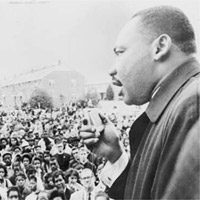 |

牧師馬丁‧路德‧金恩博士在停止賽爾碼遊行的時候向群眾談話

|
 |
|
 |
賽爾碼 (Selma) 的第一次遊行:1965年3月7日
西元1965年3月7日,有525位民眾正準備從賽爾碼遊行至阿拉巴馬州的蒙哥馬力郡 (Montgomery) ,這也是所謂的示威運動。當阿拉巴馬州的警官們在賽爾碼市外圍的愛德蒙配特司橋 (Edmund
Pettus Bridge) 與這些示威民眾發生衝突時,這一天成為歷史上的「血腥星期天」 (Bloody
Sunday) 。為什麼這些人要遊行呢?
內戰結束後的一百年,非裔美國人還是無法突破種族上的障礙,擁有自己的投票權。非裔美人幾乎佔了賽爾碼市所有人口的一半以上,但是其中只有百分之二的人擁有投票權。白人在這裡總是以歧視與脅迫的態度來對待黑人,讓他們無法享有投票權。所以這些民眾決定要以示威遊行的方式,來爭取公平的投票權待遇。
When 525 people started a planned march from Selma to Montgomery, Alabama, on Sunday March 7, 1965, it was called a demonstration. When state troopers met the demonstrators at the edge of the city by the Edmund Pettus Bridge, that day became known as "Bloody Sunday." Why were the people marching?
One hundred years after the end of the Civil War, many African Americans were still facing barriers which either prevented or made it very difficult for them to register to vote. In Selma, African Americans made up almost half the population, but only two percent were registered voters. Discrimination and intimidation tactics aimed at blacks kept them from registering and voting. The demonstrators marched to demand fairness in voter registration.

 1/3 頁
1/3 頁

|





